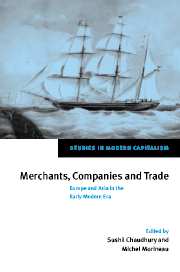Book contents
- Frontmatter
- Contents
- List of contributors
- Preface
- Introduction
- Part I Asia, especially India, around 1500
- Part II Routes, markets and merchants
- Part III European presence in Asia
- 8 The Portuguese and the Dutch in Asian maritime trade: a comparative analysis
- 9 Competition or collaboration? Relations between the Dutch East India Company and Indian merchants around 1680
- 10 The French India Company and its trade in the eighteenth century
- 11 Sweden and India in the eighteenth century: Sweden's difficulty in gaining access to a crowded market
- 12 The ambitions of the Austrian Empire with reference to East India during the last quarter of the eighteenth century
- Part IV Implications of trade: Asia and Europe
- Index
10 - The French India Company and its trade in the eighteenth century
Published online by Cambridge University Press: 02 December 2009
- Frontmatter
- Contents
- List of contributors
- Preface
- Introduction
- Part I Asia, especially India, around 1500
- Part II Routes, markets and merchants
- Part III European presence in Asia
- 8 The Portuguese and the Dutch in Asian maritime trade: a comparative analysis
- 9 Competition or collaboration? Relations between the Dutch East India Company and Indian merchants around 1680
- 10 The French India Company and its trade in the eighteenth century
- 11 Sweden and India in the eighteenth century: Sweden's difficulty in gaining access to a crowded market
- 12 The ambitions of the Austrian Empire with reference to East India during the last quarter of the eighteenth century
- Part IV Implications of trade: Asia and Europe
- Index
Summary
French commercial activities appear to differ little from those of the English, Dutch or other European countries during the eighteenth century. However, this similarity is superficial; the French trade had some notable weaknesses and particularities which explain its ‘suspension’ by the French India Company in 1769, some twenty-five years before that of its Dutch counterpart, some forty-five years before the Swedish Company, and nearly ninety years before the English Company which finally ceased its activities in 1858.
The ‘Asian abyss’
Of the total cargo value shipped by the French to Asia 75 per cent was in precious metals, especially gold and silver. While it was a fact that no European trading company, except to some degree the Dutch, escaped the requirement of carrying a silver cargo, it does appear that the French were obliged to carry a notably higher proportion than the others. In addition, the statistics for the period 1725 to 1769 (see Table 10.1) indicate that while the quantity of silver shipped decreased, the total value of loads increased. For example, for the period 1725 to 1729 the figures show that the proportion of metals was 89 per cent of the total with an annual value in livres tournois of 4 million, while between 1745 and 1749 the respective figures were 80 per cent and 6 million, and between 1765 and 1769 they were 44.6 per cent and 4.5 million.
Three-quarters of the precious metals were sent to India, with the remainder being shipped to China and to a lesser extent to the Mascarenes.
- Type
- Chapter
- Information
- Merchants, Companies and TradeEurope and Asia in the Early Modern Era, pp. 202 - 211Publisher: Cambridge University PressPrint publication year: 1999
- 1
- Cited by



